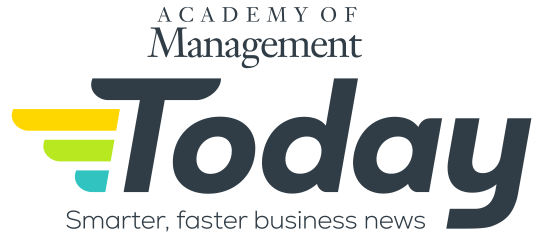Published on: June 2, 2025 at 5:49 pm
By Nick Keppler
Any act of corporate wrongdoing—real or perceived—can be publicized worldwide instantly via the internet and social media. This has made ideas of sustainability and corporate social responsibility (CSR)—which includes organizations’ initiatives geared toward achieving environmental, ethical, philanthropic, and financial objectives—increasingly important and far-ranging, said Academy of Management Scholar Herman Aguinis of the George Washington School of Business.
“Because of information flow across the internet, now we know about sweatshops, we know about companies polluting the environment, and we know about companies that are abusing and taking advantage of farmers and not providing benefits,” he said.
Not coincidentally, measurements of CSR initiatives that make a positive societal impact have grown not just to consider the company’s adherence to laws and regulations but also its impact on globalization, technological developments, fair trade, workers’ rights, pay equity, pollution, habitat destruction, and climate change.
“The expectations have changed mostly because of pressure from the outside,” Aguinis said.
To manage an increasingly complex set of considerations related to CSR and sustainability, many companies have emphasized the three Ps, Aguinis said: people, the planet, and profit.
The “people” aspect does not only encompass employees and shareholders but also a wide span of stakeholders, including “the communities you serve, your customers, the communities around your business locations,” he said.
For example, Intel, a computer components manufacturer, holds town-hall meetings before finalizing plans to open new chip plants.
Small steps like these make operating the business easier and bolster its reputation, Aguinis said.
“The argument is that you can do good and do well at the same time, that those things go hand in hand, is replacing an older cynical argument that some economists have proposed, which is that your priority and loyalty group and number-one stakeholder is your shareholders,” he said. “‘You should just be making money for them, and anything else that you do that goes outside of that is not your mandate, not your responsibility.’”
That thinking—exemplified by American economist Milton Friedman—will not help companies stand up to increasing social pressure and could hurt their reputation, Aguinis said.
“The CSR movement has changed because customers, consumers, vendors, and partners want companies to do more to impact society positively.”
-
Nick Keppler is a freelance journalist, writer, and editor. He has written extensively about psychology, healthcare, and public policy for The New York Times, The Washington Post, Slate, The Daily Beast, Vice, CityLab, Men’s Health, Mental Floss, The Financial Times, and other prominent publications (as well as a lot of obscure ones). He has also written podcast scripts. His journalistic heroes include Jon Ronson, Jon Krakauer, and Norah Vincent.
Before he went freelance, he was an editor at The Houston Press (which is now a scarcely staffed, online-only publication) and at The Fairfield County Weekly (which is defunct).
In addition to journalism, he has done a variety of writing, editing, and promotional development for businesses and universities, including the University of Pittsburgh and Carnegie Mellon University, and individuals who needed help with writing projects.
View all posts
Tagged #ManagerEffectiveness #LeadershipChallenges #WorkplaceCulture #OrganizationalBarriers, CSR, ESG, line managers, management, manager learning and development, manager promotions, manager training, managers, middle managers, mission, positive societal impact, purpose, societal impact, sustainability, sustainable business management
Up next....
Why Mending, Not Ending, DEI Programs Is Good for Business
Source: Shutterstock
By Nick Keppler
The 2020 police murder of George Floyd was a tipping point leading toa far-ranging acknowledgement of institutional inequities in the U.S. Many large, public-facing companies— including Walmart, Meta, and Amazon—responded by instituting diversity, equity, and inclusion (DEI) programs with the stated goal of identifying and eliminating their own internal barriers for historically marginalized groups. By 2022, DEI consultation was a $9.4 billion industry, and the number of jobs implementing and running DEI programs quadrupled from 2010 to 2022.
Almost as quickly as they embraced DEI, many of the same companies curtailed or downplayed those programs following the reelection of U.S. President Donald Trump, who has called DEI initiatives “illegal.”
For some, DEI is a process for powerful institutions to redress their own place in an unequal society. For others, it’s a form of discrimination and an opening for misplaced shame.
Public debate over DEI often misses an important point, according to Academy of Management Scholar Herman Aguinis of the George Washington University School of Business: Diversity is good for business.
“Research shows that when you have more diverse opinions and you’re more inclusive with people, everyone feels they belong, you have lower turnover, improved performance, and improved satisfaction—when you do it right,” he said.
World Economic Forum research showed that companies with higher marks in diversity achieve better revenue from innovation. A McKinsey & Company study found that companies in the top 25 percent for both racial and gender diversity in their industries were more likely to have superior financial returns than the average company.
“I am in favor of including more diverse perspectives in the workforce because research shows that that’s good for decision making,” said Aguinis. “It’s good for firm performance.”
But Aguinis also understands the backlash. He said that quota systems, where people with specific characteristics are put into positions of visibility to improve the company’s image, do not advance the diversity of perspectives that would spark a financial advantage. They also create a perception that others are advancing without the requisite knowledge, skills, and abilities.
“The phrase ‘DEI hire,’ I think, gives us an indication of the things that upset these people,” he said.
Aguinis was one of 23 scholars who contributed to an editorial in an international scholarly journal objecting to Trump’s targeting of DEI programs. He wrote, “Rather than eliminating DEI efforts, organizations should focus on improving them by expanding inclusive hiring practices, establishing clear accountability measures, integrating DEI into workplace strategy and culture, and implementing a comprehensive evaluation system.… In short: Mend it, don’t end it.”
-
Nick Keppler is a freelance journalist, writer, and editor. He has written extensively about psychology, healthcare, and public policy for The New York Times, The Washington Post, Slate, The Daily Beast, Vice, CityLab, Men’s Health, Mental Floss, The Financial Times, and other prominent publications (as well as a lot of obscure ones). He has also written podcast scripts. His journalistic heroes include Jon Ronson, Jon Krakauer, and Norah Vincent.
Before he went freelance, he was an editor at The Houston Press (which is now a scarcely staffed, online-only publication) and at The Fairfield County Weekly (which is defunct).
In addition to journalism, he has done a variety of writing, editing, and promotional development for businesses and universities, including the University of Pittsburgh and Carnegie Mellon University, and individuals who needed help with writing projects.
View all posts
Up next....
Research Findings Are Not Reaching Business Leaders
Source: Shutterstock
By Nick Keppler
There are now about 400 journals for management as an academic field, producing about 12,000 published articles a year in total. However, top decision-makers rarely learn anything from them, said Academy of Management Scholar Herman Aguinis of the George Washington University School of Business.
“Many of us are concerned that the research we do is not being used to the extent that we would like, and it’s called a research-practice gap,” Aguinis said. “Also, there’s a research-policy gap,” stemming from political leaders’ lack of familiarity with research produced in the field of management.
This gap is particularly frustrating, said Aguinis, because scholars on management and organizations have produced a wealth of scientifically sound research on issues that have dominated the news in 2025, including the downsizing of the federal government, the measurement of job performance, discrimination and diversity, equity, and inclusion policies, and the implementation of AI in workplaces.
“If you want to build a bridge, you will talk to the top engineers, but management scholars are not consulted with the same regularity,” said Aguinis.
This is not entirely the fault of those who could potentially benefit from our research, Aguinis added. Academic journals are often insular and publish articles that only make small contributions to our understanding of critical organizational phenomena. Also, the compensation and reward systems motivate academics to write mainly for other academics, not managers, business leaders, and decision-makers.
“For several reasons, much of our research is not aimed at affecting practice,” Aguinis said. “If you read the typical article of, let’s say, 20 pages, you may find one or two paragraphs at the end saying ‘implications for practice.’”
The research is not lost on everyone. A small number of elite companies look to academia to improve performance. Google is well-known for hiring Ph.D. holders, not just for computer-science roles but also for management and creative jobs. Marriott is a sponsor of doctoral development programs.
These companies reap the benefit in reputation, said Aguinis, often appearing in lists such as Fortune Magazine’s “Best Companies to Work For” series.
“All of these companies, all of them, employ Ph.D.s who actually read the research, and they try to implement leadership strategies and management practices that are consistent with what research says aligns with best-practice evidence as published in scholarly journals,” he said.
-
Nick Keppler is a freelance journalist, writer, and editor. He has written extensively about psychology, healthcare, and public policy for The New York Times, The Washington Post, Slate, The Daily Beast, Vice, CityLab, Men’s Health, Mental Floss, The Financial Times, and other prominent publications (as well as a lot of obscure ones). He has also written podcast scripts. His journalistic heroes include Jon Ronson, Jon Krakauer, and Norah Vincent.
Before he went freelance, he was an editor at The Houston Press (which is now a scarcely staffed, online-only publication) and at The Fairfield County Weekly (which is defunct).
In addition to journalism, he has done a variety of writing, editing, and promotional development for businesses and universities, including the University of Pittsburgh and Carnegie Mellon University, and individuals who needed help with writing projects.
View all posts
Up next....
Going Beyond Surface-level Diversity Key to Avoiding Bias
Source: Shutterstock
By Nick Keppler
Spurred by the racial reckoning after the 2020 police murder of George Floyd, many large, public-facing companies in the U.S. implemented diversity, equity, and inclusion (DEI) programs with the stated goal of addressing their own barriers to hiring of, and advancement for, historically disadvantaged groups.
Too often, these efforts are only aimed at what Academy of Management Scholar Herman Aguinis of George Washington University calls “surface-level diversity,” the presence of people of different races, ethnicities, genders, and other classifications without a change in corporate culture led by executives who value varying perspectives.
“Deep-level diversity is when you have people around the table who bring different experiences and opinions and perspectives to the table, and organizational leaders listen to those diverse voices,” Aguinis said, who has both researched and consulted on institutional barriers that prevent the rise of “star performers” from various backgrounds.
“Surface-level diversity is when you look at someone’s gender, skin color, or race or ethnicity, and that’s what you call diversity,” he said. “It’s much easier to go for surface-level diversity.”
This gravitation towards superficial diversity often starts at the recruitment and interview stages. People in charge of hiring tend to like people with views and appearances similar to their own, said Aguinis, and they can slip into looking for candidates who have the same race, ethnicity, gender, and background as they do.
To prevent bias from creeping into the recruitment and hiring processes, Aguinis recommends conducting structured interviews.
“In a structured interview, you ask the same questions to all the candidates, and you actually score the answers with a scoring key you have created in advance,” he said. “If you have an unstructured interview, where you just chit-chat with a candidate, you’re more likely to like them or not, based on how similar they are to you.
“Also, you should never have just one interviewer because that person’s biases are more likely to be undetected.”
Aguinis added that the perception of a superficial quota system is one cause of a backlash that has led many companies to roll back or rebrand DEI efforts.
“When companies use it—the shortcut of surface-level diversity and just trying to use quotas or things like that—that’s when the diversity seems to be the opposite of what it tries to do: being exclusive instead of inclusive,” he said.
-
Nick Keppler is a freelance journalist, writer, and editor. He has written extensively about psychology, healthcare, and public policy for The New York Times, The Washington Post, Slate, The Daily Beast, Vice, CityLab, Men’s Health, Mental Floss, The Financial Times, and other prominent publications (as well as a lot of obscure ones). He has also written podcast scripts. His journalistic heroes include Jon Ronson, Jon Krakauer, and Norah Vincent.
Before he went freelance, he was an editor at The Houston Press (which is now a scarcely staffed, online-only publication) and at The Fairfield County Weekly (which is defunct).
In addition to journalism, he has done a variety of writing, editing, and promotional development for businesses and universities, including the University of Pittsburgh and Carnegie Mellon University, and individuals who needed help with writing projects.
View all posts
Up next....
Why Success Can Be the Enemy of Innovation in the Age of AI
Source: Shutterstock
By Jason Collins
A new Pew Research Center report reveals that public optimism remains low regarding the potential impact of AI in the workplace. However, refusing to work with new technologies can cause even the largest organizations to fail as this technology changes the game across many industries.
Academy of Management Scholar Wendy Smith of the University of Delaware reveals that it isn’t the small businesses that are most at risk, but rather larger organizations that choose to rely on what they know works. Smith calls this the paradox of success.
“The companies who are at the top of their market have the most to lose and therefore don’t want to take risks and thus are the most entrenched in what they already do,” Smith said. “Researchers call this the ‘paradox of success’ where successful companies are the ones that fail to adopt new technologies and innovation.”
Because smaller organizations don’t have this burden, they have nothing keeping them from trying new things and adopting new technologies such as AI and robotic process automation. History shows us that success can be an enemy of innovation. Smith draws parallels to brands such as Kodak and Polaroid, which failed to make the digital photography transition.
“BlackBerry was this amazing early force of the smartphone but could not compete when brands like Apple came into the market with updated technologies,” Smith said. “Blockbuster Video couldn’t make the transition from VHS tapes and DVDs to streaming when Netflix then took over.
“So, we see that story happen again and again and again,” she said.
If the past has taught us anything, it is that relying on past success without monitoring new technologies, tracking consumers’ preferences, and cultivating boldness in strategic planning prevents innovation.
“I think we’re going to see the same thing now,” Smith said. “And so there is wisdom in ‘Don’t throw out the baby with the bathwater.’
“It’s totally new technology, but leaders should be learning from history what it means to innovate within an existing company,” she said.
Up next....
Rethinking Management in the Age of AI
Source: Shutterstock
By Jason Collins
More than one in four workers are worried that AI will lead to job losses, according to a recent poll from the conciliation service Acas. Currently, leaders and management have a key role in shaping how employees use AI during this technological transition.
Instead of viewing AI as a potential replacement for human workers, management can be more effective by considering how people can interact with technology to boost productivity and efficiency. Academy of Management Scholar Wendy Smith of the University of Delaware said that doing so requires that senior management shift their mindsets to frame the relationship between humans and AI in the context of what works in their organization.
“One of the roles of leaders is to understand how AI and humans work together,” Smith said. “We tend to think of how technology will replace human, which is an either/or mindset.”
Instead, she urged leaders to frame technology as a complement to, not a replacement for, employees.
“Leaders can adopt a both/and approach, exploring how AI and employees work together to lead to even better outcomes,” Smith said.
Smith advised management to adopt the mindset of using AI to make their team members’ jobs easier and free up time for them to focus on strategic planning and other tasks that require higher-order thinking.
“AI works better because the person and the technology are in a relationship with one another,” Smith said. “We can do better when we ask ourselves, ‘What is this technology good for? What is my level of understanding of it? What am I good for, what do I do well, and how could I work effectively and interdependently with this technology?’”
Smith said that she believes that while AI can perform certain tasks more efficiently than humans, it ultimately comes down to collaboration. For example, the better the prompts that humans give to a generative AI platform, the better the outputs of the gen AI software. Human expertise can help evaluate and assess the quality of the AI responses.
“If AI is going to work to the best of its capabilities, it’s because I bring real and important contributions to the table,” Smith said.
For managers, the question is no longer whether to use AI but how to grow with it and encourage rank-and-file employees to do the same. Smith said this will require “growth and thoughtfulness.” Smith also underscored the advice for people to “recognize that AI and humans work better together, and to be in learning and growth mode.”
Up next....
Human-Centered Leaders Steer Through the AI Anxiety Curve
Source: Shutterstock
By Jason Collins
Established generative AI platforms such as OpenAI’s ChatGPT, Google’s Gemini (formerly Bard), Anthropic’s Claude, and Jasper (formerly Jarvis) have been competing for users and market share, and the level of competition in the space will continue to grow with the rise of non-U.S. AI startups, including Chinese company DeepSeek. The impact of this new technology in the workplace is far-reaching, and leaders need to guide their organizations’ employees through their psychological resistance with an approach that embraces innovation while acknowledging the potential positive and negatives effects on humans and our emotions.
Academy of Management Scholar Wendy Smith of the University of Delaware noted that history has shown us that when a new generation of technology is introduced, such as generative AI, we resist it psychologically. Smith explained that AI is a great example of this.
“AI introduces all kinds of uncertainty and possibilities, some exciting, others anxiety-inducing,” Smith said.
“It’s a wide range of possibilities, which includes automation of manual tasks, role changes, and job losses, and that type of uncertainty leads us to psychologically fill in the gaps with all kinds of things that we’re afraid of,” she said.
It introduces the question, “What happens with the people who had been doing the work but whose skills are no longer relevant or up to date?”
This AI anxiety curve is not a new concept. Smith cited the introduction of once-disruptive technologies that we now take for granted.
“We’ve seen that story play out in every industry,” Smith said. “For example, we’ve seen how the introduction of the personal computer overtook the mainframe, and the introduction of cloud computing overtook the personal computer.
“We’ve seen it in the past, and when it comes to technology in general is, as a result of this anxiety, there’s this curve of people adopting the anxiety,” she said.
Smith noted that this spread of emotional reactions results in a wave of people, especially in the workplace, feeling this anxiety and thus holding out for the new technology to become more established before gauging its implications, or dismissing its potential to create positive outcomes. Leaders cannot afford to ignore this anxiety. If they are to continually innovate, they need to take into account employees’ emotional responses.
“Effective innovation requires attention to, not rejection of, employees’ emotional experiences,” Smith said.
“The best leaders navigate this learning and adoption curve across the organization with empathy for their workers and clarity on the objectives for deploying the technology with a human-centered approach to leadership that also embraces innovation,” she said.
Up next....
The New Reality: Leaders Have Less Control, Need More Courage
Source: Shutterstock
By Jason Collins
For decades, the prevailing wisdom for business leaders was to stay out of politics. Neutrality was considered the safest, most responsible stance for corporate executives and board members to take. But today that approach is increasingly untenable. From the COIVID-19 pandemic to intensifying political polarization and controversy, leaders now find themselves at the center of public debates whether they choose to engage with them or not.
For leaders, silence is a statement, and political neutrality is no longer a viable option, according to Academy of Management Scholar Wendy Smith of the University of Delaware.
“It used to be that there were checks and balances in the U.S. government,” Smith said. “The market was separate from the state, or companies were separate from the government, and that is no longer the case.”
To survive and thrive in this era when economics and politics collide to sow chaos, Smith said that leaders should “talk about strategizing as a verb rather than having a strategy.” For Smith, this means considering “the conditions that we need to bring a team together to be agile and moving, even as we need to communicate out to our people some sense of security.”
Strategic decisions from supply-chain choices to remote, hybrid, or return-to-office work policies have become flashpoints in boardroom and C-suite conversations and political discourse. Leaders now must navigate complex social, economic, and political terrains, speak out on pressing issues, and align their actions with values that resonate with stakeholders—employees, shareholders, customers, and communities alike.
Companies’ leaders have had to deal with uncertainties for a long time, but Smith said many of their strategies and their organization’s systems are antiquated. According to Smith, nowadays leaders are learning that they need to “communicate to their people, optimize their processes, and cultivate openness in their conversations, but not pretend that there’s certainty of what the future will bring, because that’s just false hope.”
Smith acknowledged that leaders are faced with unique challenges in this current political landscape characterized by dissention, frustration, anger, and unpredictability, making it difficult to navigate socioeconomic volatility.
“One of the consequences of this highly polarized world is that leaders, because of the polarization, are being attacked for polarizing positions,” Smith said.
In this current era, leadership is less about having definitive answers and more about asking incisive questions, listening to a range of perspectives, evaluating various responses to difficult circumstances and controversial issues through an ethical lens, and having the courage of one’s convictions.
“We want leaders who are competent and courageous, not stepping away from that responsibility to take a stand and speak up for what’s right because it is so risky,” Smith said.
-
Daniel Butcher is a writer and the Managing Editor of AOM Today at the Academy of Management (AOM). Previously, he was a writer and the Finance Editor for Strategic Finance magazine and Management Accounting Quarterly, a scholarly journal, at the Institute of Management Accountants (IMA). Prior to that, he worked as a writer/editor at The Financial Times, including daily FT sister publications Ignites and FundFire, as well as Crain Communications’s InvestmentNews and Crain’s Wealth, eFinancialCareers, and Arizent’s Financial Planning, Re:Invent|Wealth, On Wall Street, Bank Investment Consultant, and Money Management Executive. He earned his bachelor’s degree from the University of Colorado Boulder and his master’s degree from New York University. You can reach him at dbutcher@aom.org or via LinkedIn.
View all posts
Up next....
“Just Add a Woman and Stir” Is Not Enough for Board Success
By Daniel Butcher
Even at organizations that have made strides in adding women and people of color to their governing boards, tokenism is all too common. Diverse board members can’t make a difference if their longer-tenured colleagues routinely disregard their suggestions.
Academy of Management Scholar Kris Byron of Georgia State University said that female board members and those representing an ethnic or racial minority are often sidelined, technically part of the board but to whom the other directors or trustees don’t really listen.
Byron and research colleague Corinne Post of Villanova published an article on this topic in Academy of Management Journal.
“There’s this idea that you just add women and stir and that’s enough, but that’s not enough,” Byron said. “If we’re saying that the ways in which a woman might add value is that she might have different perspectives or a different lens through which to look at an issue, or she might have information or knowledge or experience that maybe some of her male colleagues don’t have.
“That knowledge, experience, and perspectives mean nothing—they’re not going to have any effect—if people aren’t willing to acknowledge the usefulness of that perspective or knowledge or experience,” she said. “There’s probably lots of other things that are important to whether or not the woman on the board is a token, or whether or not there’s some kind of critical mass of female directors on the board.
“Do people think, ‘Oh, she’s just there on the board because we had to fill this quota—she wasn’t the best person to serve in this role; she’s just here for window dressing to make us look good.’”
Diversity is hollow if it isn’t accompanied by equity, inclusion, and fostering a sense of belonging among members of marginalized and minority groups. Actually listening to female board members’ ideas and suggestions and enacting the best of them are crucial for them to have a chance to improve an organization’s leadership.
“There has to be this real belief among the other board directors that these women, that all of the directors, have some value-add, and that isn’t a given,” Byron said. “So that’s what it means that you can’t just add women and stir.
“There has to be some other things that are in place in order for women to have a positive impact on an organization, especially on something that’s so distal or downstream like firm performance,” she said. “Board directors largely have an indirect effect on organizational performance.”
-
Daniel Butcher is a writer and the Managing Editor of AOM Today at the Academy of Management (AOM). Previously, he was a writer and the Finance Editor for Strategic Finance magazine and Management Accounting Quarterly, a scholarly journal, at the Institute of Management Accountants (IMA). Prior to that, he worked as a writer/editor at The Financial Times, including daily FT sister publications Ignites and FundFire, as well as Crain Communications’s InvestmentNews and Crain’s Wealth, eFinancialCareers, and Arizent’s Financial Planning, Re:Invent|Wealth, On Wall Street, Bank Investment Consultant, and Money Management Executive. He earned his bachelor’s degree from the University of Colorado Boulder and his master’s degree from New York University. You can reach him at dbutcher@aom.org or via LinkedIn.
View all posts
Up next....
What Are the Effects of Adding Women to Boards? It’s Complicated.
By Daniel Butcher
Research shows that companies with more female directors can have better firm performance—and this is especially the case in countries that have stronger shareholder protections or that have greater gender equality. In addition, organizations whose boards have more female directors tend to be more engaged in activities that are central to boards’ responsibilities: monitoring and strategy involvement.
Academy of Management Scholar Kris Byron of Georgia State University said that board monitoring refers to the extent to which boards engage in activities that entail oversight of the firm and seek to control managers. Board strategy involvement refers to the extent to which boards engage in activities related to their advising role and decide how firms should compete in the marketplace.
Byron and research colleague Corinne Post of Villanova published an article on this topic in Academy of Management Journal.
“What we found was that there was a positive effect of adding women to the board on strategic involvement and a positive impact on board monitoring, but that board diversity is neither wholly detrimental nor wholly beneficial to firm financial performance,” Byron said. “There is some research showing that when you have more women on your board, they’re more likely to influence fellow directors’ or trustees’ behavior and that the norms of the board changes, for example, attendance gets better.
“There’s this spillover effect that women might have; maybe they come onto the board and they’re more diligent,” she said. “In some ways, that makes sense, because there aren’t tons of women who are in those kinds of senior positions, and so, if she got to that position, then she is probably quite exceptional and especially conscientious.
“Those behaviors may spill over to her male counterparts on the board, and there is research suggesting that that’s something that probably occurs.”
-
Daniel Butcher is a writer and the Managing Editor of AOM Today at the Academy of Management (AOM). Previously, he was a writer and the Finance Editor for Strategic Finance magazine and Management Accounting Quarterly, a scholarly journal, at the Institute of Management Accountants (IMA). Prior to that, he worked as a writer/editor at The Financial Times, including daily FT sister publications Ignites and FundFire, as well as Crain Communications’s InvestmentNews and Crain’s Wealth, eFinancialCareers, and Arizent’s Financial Planning, Re:Invent|Wealth, On Wall Street, Bank Investment Consultant, and Money Management Executive. He earned his bachelor’s degree from the University of Colorado Boulder and his master’s degree from New York University. You can reach him at dbutcher@aom.org or via LinkedIn.
View all posts
Up next....
What It Takes to Be a Powerful Leader
Source: Shutterstock
By Daniel Butcher
To climb the ladder in your profession and achieve success, hard work is table stakes, not a differentiator. And to progress from rank-and-file employee to manager to respected, powerful leader might require a fundamental mindset shift of letting go of a need to be seen as likeable and authentic while cultivating professional relationships.
Academy of Management Scholar Jeffrey Pfeffer of Stanford University, one of today’s most influential management professors and researchers, offers some takeaways on that subject from his book7 Rules of Power, which isa manual for increasing the ability to get things done and benefitting from job performance.
“Good performance by itself is not necessarily going to bring you the level of career success that you need,” Pfeffer said. “In addition, you need technical and political skills to have your boss recognize your good contributions.
“If you think about management, and leadership is managing through other people, you need to learn how to interact with other people across your organization in ways that build your influence and permit you to get the things done that you want to get done,” he said.
Pfeffer’s seven rules power are:
1. Get out of your own way: “Lose the self-descriptions and inhibitions that hold you back, for example, the idea that you have to be liked, because, as an executive, you’re hired to get things done, not necessarily to win a popularity contest. Lose this currently popular idea that you need to be quote-unquote authentic, which is, of course, incorrect.”
2. Break the rules: “In strategy and organizational leadership, if you do what everybody else does, you will probably not succeed—you need to differentiate yourself.”
3. Show up in powerful fashion: “Body language and how we communicate is obviously important.”
4. Create a powerful brand: “If you’re perceived as a powerful, effective, efficacious leader, then that becomes a self-fulfilling prophecy—good people want to work with you, invest with you, and buy from your company.”
5. Network relentlessly: “That’s something that people often don’t want to do, so they underinvest in networking because they feel dirty about it and don’t see it as the value-adding activity that it is.”
6. Use your power: “Not all use of power will be met with unalloyed approval, so leaders need to be willing to incur some level of social disapproval. But because most people are usually averse to conflict, it is surprising how much one can accomplish by seizing the initiative.”
7. Understand that once you have acquired power, what you did to get it will be forgiven, forgotten, or both: “Once you have power and status and success, no one will care how you got it, and people will people will accommodate themselves, because people like to be close to power.”
Upon reading or hearing about those precepts and their implications for workplace power dynamics, many people have an adverse reaction. That’s natural and understandable, Pfeffer said.
“Every person should understand and come to terms with the seven rules of power, and most will go through stages: first, denial—‘This doesn’t work in my organization’s culture’—then they will have anger, which will mostly be directed at me, which is fine,” he said. “Then they will have sadness—‘I’m depressed by it’—and finally, they often come to acceptance that this is not only the way the world works, but they can build agency around this.
“My biggest contribution is causing them to see their own agency and encouraging them to be more ambitious and more agentic around navigating their own career and getting their boss to recognize their talents, instead of sitting back and waiting for the human resources department to offer promotions and raises.”
-
Daniel Butcher is a writer and the Managing Editor of AOM Today at the Academy of Management (AOM). Previously, he was a writer and the Finance Editor for Strategic Finance magazine and Management Accounting Quarterly, a scholarly journal, at the Institute of Management Accountants (IMA). Prior to that, he worked as a writer/editor at The Financial Times, including daily FT sister publications Ignites and FundFire, as well as Crain Communications’s InvestmentNews and Crain’s Wealth, eFinancialCareers, and Arizent’s Financial Planning, Re:Invent|Wealth, On Wall Street, Bank Investment Consultant, and Money Management Executive. He earned his bachelor’s degree from the University of Colorado Boulder and his master’s degree from New York University. You can reach him at dbutcher@aom.org or via LinkedIn.
View all posts













